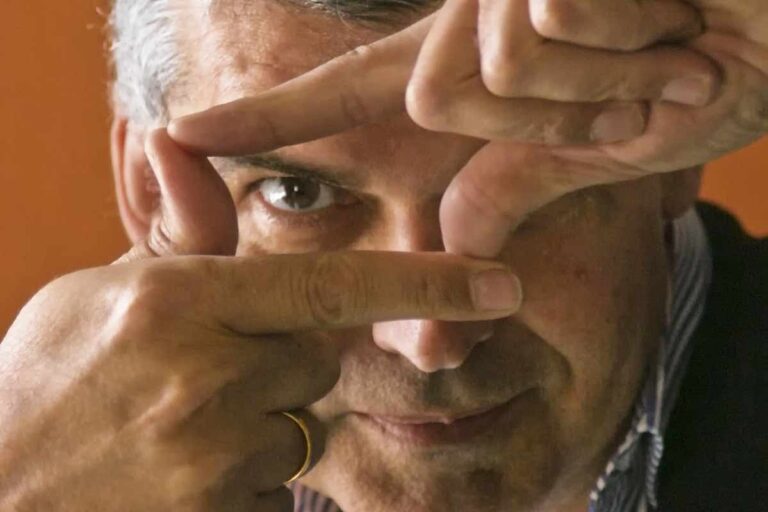Om Shanti Shanti Om
I welcome you with all my heart. Sorry, you will have to bear with me, but I had cataract surgery just before the quarantine started, and in the mornings my eyes are watering. I’m not crying, it’s just that my eyes are watering (Luis laughs). What we are going to do today and tomorrow morning is to turn our attention inward. We are always focused on the world, from here to the world. We are constantly seeing, smelling, tasting, touching, and what we are going to do now is simply to turn our attention, which is usually focused on the world. We are going to turn it around. We are going to focus our attention on our own center, where what we are is really found, where what we are seeking is found. We can look with eyes closed, close our eyes and look within, and once you are looking within, look deeper, and even more deeply, because there is no bottom. We dive into ourselves and enjoy what we are, as if we were diving into a swimming pool, one with no bottom. And we are not going to run out of air, we can still breathe, and we can go deeper and deeper, diving more and more, until the mind comes and takes us out. Because there is no doubt the mind will come, take us out, and bring us back into the world. And when you notice that the mind has taken you out and brought you back into the world, with ideas, with suggestions, with thoughts, just notice it and turn your attention back again, dive into yourself. It’s not a problem, it’s like a game, just a game you’re playing with your mind. The mind will take you out, and when you notice that the mind has taken you out, you just dive again, without any fuss, without worrying about it. It’s normal, the mind is doing its usual job, which is to take you out of what you are, so that you cannot see the all beauty that lies within you. And when you notice that the mind has achieved its goal, just accept it and say, “oh look, the mind took me out again”, and then turn your attention again and dive in. It’s a game, you’re playing hide and seek, you’re looking for what you are, you find it and you immerse yourself in it. Then the mind comes and hides it from you. And when the mind hides it, you just seek it again, you look and you dive in. Somehow the mind will at some point come back and hide it again, and you go out to look for it again. Besides, now you know where it is. You dive again, and the more you play this game, the longer you will stay immersed deep into yourself, and the mind will have less and less power to hide it. Keep playing.
(Long pause)
In the Advaita tradition this is called Atma Vichara; I don’t know exactly how that is translated. In the West we usually translate it as self-enquiry, but it really has nothing to do with inquiring or asking ourselves questions. It is called self-enquiry because one of the ways in which Ramana taught to turn the attention inwards was by means of a question. Ramana taught that you have to watch your mind, and when a thought comes, then you ask, “who is having this thought?”, or “to whom does this thought come?” The answer is: me. Then, who am I? At that point you don’t try to answer, you just ask “who am I?”, and let that which I am answer. It will not answer with words, it is not going to use concepts. If an answer comes to you with words or concepts, it means you are using the mind. The mind is inserting itself where it doesn’t belong.
But once you get used to turning your attention inward, it is no longer necessary to ask any question. You just need to observe your thoughts and keep watching them, patiently, without trying to do anything, without trying to make them go away, without trying to change them. Just watch them. They are going to dissolve, and not only are they going to dissolve, but they are also going to go back into their source, they will take you to their source, like Hop-o’-My-Thumb’s crumbs, because all of this which we call world actually comes out of here (Luis touches his heart). So simply by observing your thoughs , they will start to dissolve, and it will take you back to its source. This is how Robert Adams used to teach it. Robert Adams said that you could start by using the question, at the beginning, but after some time the question is no longer necessary.
No doubt there are reasons for translating Atma Vichara as “self-enquiry”, but these words don’t really describe what Atma Vichara is. Atma Vichara is simply turning your attention within and looking in the direction where what you are seeking is actually found. Until now you have been looking where it was not, and by now you are sure of that. Now start to look where it is, look, dive in and enjoy, and dive deeper, dive deeper…
(Long pause)
Atma vichara, or turning our attention within, or whatever you want to call it… don’t make it into technique, don’t make it into a meditation or like a routine within your life. Because turning our attention within is something natural, something that happens naturally when we fall silent and stop paying attention to the world. When we do these two things, our attention immediately and naturally goes to what we really are. It’s not a mantra, it’s not a technique, it’s not a meditation. Just create the atmosphere in which this inward shift of your attention can happen naturally in your life. At the beginning it’s much easier to do in Satsang, later it becomes easier when you are at home in silence and you have removed all distractions. But we must not stop there, because turning our attention within can happen together with everything we do in our life: going down the street, riding the subway, cooking, taking care of our children… all the time we can have our attention turned within.
Luis de Santiago
Satsang in La Coruña, 25th April 2020

